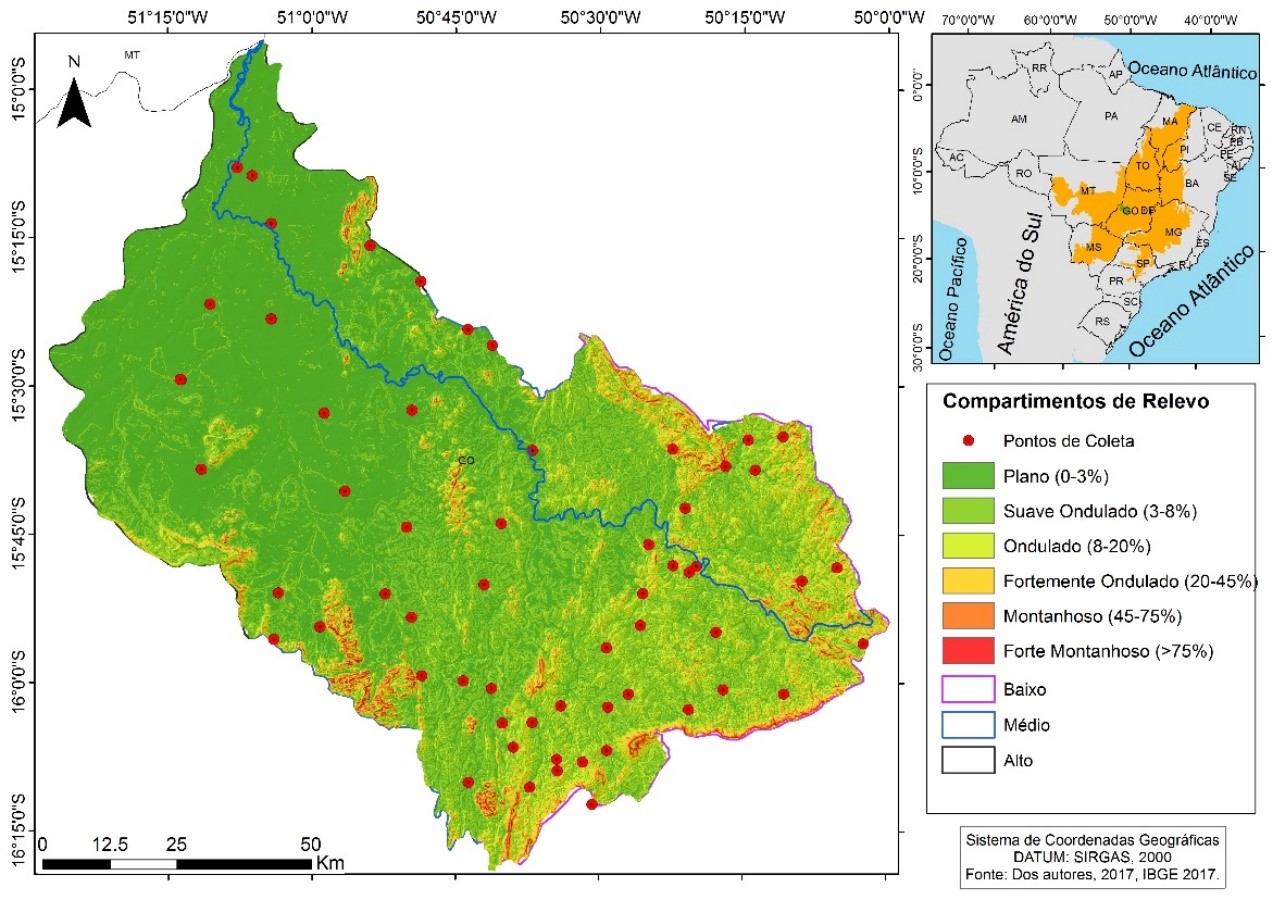Resumo
A pecuária no Brasil teve papel relevante na formação do espaço rural. Tal processo ocasionou um passivo ambiental, pois se desenvolveu sem considerar os impactos ao meio ambiente, relativos à erosão e compactação dos solos, emissão de gases de efeito estufa (GEE), além do uso intensivo de terra e dos recursos hídricos. Em significativa parcela das propriedades o manejo inadequado resultou em pastagens com níveis de degradação. A literatura aponta a importância da intensificação da tecnologia como forma de garantir pastagens sustentáveis. Esta pesquisa tem por objetivo analisar a relação entre nível tecnológico de produção de bovinos e de degradação de pastagens na Bacia Hidrográfica do Rio Vermelho, em Goiás - Brasil. Esta área é considerada como representativa da pecuária no cerrado brasileiro. Foi utilizada amostra estratificada por compartimentos com 60 estabelecimentos agropecuários. Utilizaram-se as técnicas de análise de correspondência múltipla, análise de cluster e regressão beta para obter o Índice de Degradação de Pastagens (IDP). Verificaram-se associações bivariadas entre o Índice Tecnológico (IT) e as variáveis: renda, relevo e tamanho da propriedade. Foi possível constatar o emprego de maior nível tecnológico nas maiores propriedades e em terrenos mais planos. Também se constatou que o maior nível tecnológico propicia maior remuneração aos gestores. Porém não se observou relação entre a tecnologia empregada nos estabelecimentos e taxa de lotação animal, o que pode comprometer os resultados econômicos e bem-estar animal. Assim, como não foi observada associação entre índice tecnológico e índice de degradação de pastagens, sugerindo ocorrência de degradação de pastagens, mesmo quando do uso de tecnologias na produção de bovinos.
Referências
ARMENTERAS, D., et al. Landscape Dynamics in Northwestern Amazonia: An Assessment of Pastures, Fire and Illicit Crops as Drivers of Tropical Deforestation. PLoS ONE, v.8, January, 2013. https://doi.org/10.1371/journal.pone.0054310
BOWMAN, M., et al. Persistence of Cattle Ranching in the Brazilian Amazon: A Spatial Analysis of the Rationale for Beef Production. Land Use Policy, v. 29, p.558-568, 2012. https://doi.org/10.1016/j.landusepol.2011.09.009
CARO, D., et al. Greenhouse Gas Emissions Due to Meat Production in the Last Fifty Years. In: Ahmed M., Stockle C. (eds) Quantification of Climate Variability, Adaptation and Mitigation for Agricultural Sustainability. Springer, Cham, 2017. https://doi.org/10.1007/978-3-319-32059-5_2
DIAS, L.C.P., et al. Patterns of land use, extensification, and intensification of Brazilian agriculture. Global change biology, v.22, n. 8, p.2887-2903, 2016. https://doi.org/10.1111/gcb.13314
GIBBS, H. K., et al. Tropical forests were the primary sources of new agricultural land in the 1980s and 1990s. Proceedings of the National Academy of Sciences, v. 107, n.38, p.16732-16737, 2010. https://doi.org/10.1073/pnas.0910275107
GOENER, A., GLOAGUEN, R., MAKESCHIN, F. Monitoring of the Ecuadorian mountain rainforest with remote sensing. Journal of Applied Remote Sensing, v.1, n. 1, p.013527-013527-12, 2007. https://doi.org/10.1117/1.2784111
GREENACRE, M.. Correspondence Analysis in Practice. Barcelona, Chapman and Hall/CRC, 2007. https://doi.org/10.1201/9781420011234
GRIFFITH, D. C. Migration, Labor Scarcity, and Deforestation in Honduran Cattle Country. Journal of Ecological Anthropology, v. 18, n. 1, p.3, 2016. https://doi.org/10.5038/2162-4593.18.1.3
GUEDES, T. A., et al. Seleção de variáveis categóricas, utilizando análise de correspondência e análise procrustes. Acta Scientiarum. Technology, v.21, p.861-868, 2008. https://doi.org/10.4025/actascitechnol.v21i0.3084
HAIR JR., J.F., et al. Análise multivariada de dados. Trad. Adonai Schlup Sant’Anna e Anselmo Chaves Neto. 5 ed. Porto Alegre: Bookman, 2009.
IBGE - Instituto Brasileiro de Geografia e Estatística. Base Cartográfica Contínua do Brasil ao milionésimo. Ver 3. Rio de Janeiro. 2017. Available in: < https://bit.ly/2EROYLT>. Acessed: february, 12, 2018.
_____ Economia. Censo agropecuário, 2006. Available in: <https://bit.ly/3d0SazL>. Acessed: july, 05, 2017.
KLINK, C.A., MACHADO, R.B. A conservação do Cerrado brasileiro. Megadiversidade, v.1, n. 01, p.147-155, 2005. Available in: < https://bit.ly/3g9rUFa>. Acessed: August 26, 2018.
LIMA, S. S., et al. Relação entre a presença de cupinzeiros e a degradação de pastagens. Pesquisa Agropecuária Brasileira, v.46, n.12, p.1699-1706, 2012. https://doi.org/10.1590/S0100-204X2011001200016
LIMA, V. M. A., CALDARELLI, C. E., CAMARA, M. R. G. Análise do desenvolvimento municipal paranaense: uma abordagem espacial para a década de 2000. Economia e Desenvolvimento, v. 26, n. 1, p. 1-19, 2014. https://doi.org/10.5902/1414650911030
MACHADO, L.E.G., LIMA, C.V.L. Compartimentação geomorfológica da bacia hidrográfica do Rio Vermelho (GO), utilizando imagens ASTER. In: Simpósio Brasileiro de Sensoriamento Remoto – SBSR, Curitiba. Anais... São Paulo, Instituto Nacional de Pesquisa Espacial, p.8231, 2011. Available in: < https://bit.ly/2NDPOwj>. Acessed: August 26, 2018.
MARGULIS, S. Causas do Desmatamento da Amazônia Brasileira. Banco Mundial Brasília DF, 2003. Available in: < https://bit.ly/3d0SSNr >. Acessed: August 26, 2018.
MCMANUS, C., et al. Dynamics of Cattle Production in Brazil. Plos One, January 27, 2016. https://doi.org/10.1371/journal.pone.0147138
OECD-FAO – Organization for Economic Cooperation and Development, Food and Agriculture Organization of the United Nations, 2015. OECD-FAO Agricultural Outlook 2015 – Chapter 2. Paris. http://dx.doi.org/10.1787/agr_outlook-2015-4-pt
OLIVEIRA, E. R., et al. Development of a technological index for the assessment of the beef production systems of the Vermelho River Basin in Goiás, Brazil. Revista Pesquisa Operacional, v.38, n.1, p.117-134, 2018. https://doi.org/10.1590/0101-7438.2018.038.01.0117
PAGÈS, J. Multiple Factor Analysis by example using R. Chapman and Hall, CRC Press, 2014.
PERON, A.J.; EVANGELISTA, A.R. Degradação de pastagens em regiões de cerrado. [Degradation of pasture in the Brazilian Cerrado]. Revista Ciência e Agrotecnologia, Lavras, MG, v. 28, n. 30, p.655-661, 2004. https://doi.org/10.1590/S1413-70542004000300023
PINHEIRO, T. F. et al. Forest degradation associated with logging frontier expansion in the Amazon: the BR-163 region in Southwestern Pará, Brazil. Earth Interactions, v.20, n. 17, p.1-26, 2016. https://doi.org/10.1175/EI-D-15-0016.1
ROSA, A. N. et al. Peso adulto de matrizes em rebanhos de seleção da raça Nelore no Brasil. Revista Brasileira de Zootecnia, v.30, n.30, p. 1027-1036, 2001. https://doi.org/10.1016/j.rsase.2020.100288
SHIRVANI, Z., et al. Analyzing spatial and statistical dependencies of deforestation affected by residential growth: Gorganrood basin, Northeast Iran. Land Degradation & Development, 18 april, 2017. https://doi.org/10.1002/ldr.2744
WARD JR., J.H. Hierarchical grouping to optimize an objective function. Journal of the American statistical association, v.58, n.301, p.236-244, 1963. https://doi.org/10.1080/01621459.1963.10500845
Direitos Autorais para artigos publicados nesta revista são do autor, com direitos de primeira publicação para a revista. Em virtude de aparecerem em revista de acesso público, os artigos são licenciados sob Creative Commons Attribution (BY), que permite o uso irrestrito, distribuição e reprodução em qualquer meio, desde que o trabalho original seja devidamente citado.

